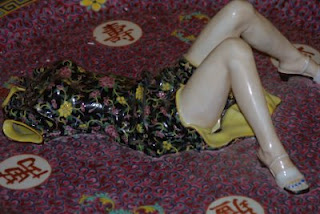While the Asian Art market reflects the general weakness of the global market, the Chinese art market remains strong due to the ever-growing demand and sophistication of private Mainland Chinese buyers. Not surprisingly, the taste of Chinese art buyers is shifting what is being offered at first-tier auction house like Sotheby’s, Christie’s and Bonham’s. Important sales are now featuring 18th century decorative arts such as blue-and-white porcelain, white jade, objects made of rhinocerous horn, with excellent provenance and produced in imperial workshops. Objects of the Qianlong period (1736-95) continue to bring in the highest prices. Hong Kong and auctions in Mainland China are now the center of the Chinese art market. However, Chinese buyers are flocking to sales not only at first-tier auction houses but also regional auction houses around the globe to chase desirable artworks being sold from significant European collections. A recent example of this is a sale at Woolley & Wallis in Great Britain where pair of imperial jade elephants were sold for $1.23 million, 3-4 times estimate and a white jade bell sold for $2.46 million. Eleven lots sold for over $100,000 and twenty-two lots sold for over $50,000.
Chinese art market remains strong
The Economist Magazine has recently published two interesting articles on the Asian art market based on recent sales in Hong Kong and Paris. The first point is that while the overall Asian Art market reflects the general weakness of the global art market, the Chinese art market is an exception. Sales remain strong due to the ever-growing demand and sophistication of private Mainland Chinese buyers. However, the markets for Japanese and Korean works of art continue to be dominated by Western collectors. This small and highly specialised group tend to buy through dealers rather than at auction. At a recent sale of Japanese art at Christie’s in Paris nearly 60% of the 125 lots failed to sell. The bought-in rate of Korean works was even worse, at well over 70%. In stark contrast, Chinese art at Paris sales had a bought in rate of only 20-30% at Sotheby’s and Christie’s with approximately 70% selling above the pre-auction high estimate! Not surprisingly, the taste of Chinese art buyers is shifting what is being offered by Sotheby’s, Christie’s and Bonhams. Important sales are now featuring 18th century decorative arts (blue-and-white porcelain, white jade, objects made of rhinocerous horn) with excellent provenance (the better to avoid the notorious fakes) from imperial workshops. Objects of the glorious Qianlong period (1736-95) continue to bring in the highest prices. Chinese buyers are flocking to Paris sales because there are still significant European collections coming up at auction. Aside from taste, Chinese buyers are highly motivated to repatriate imperial objects that in many cases had been looted by imperialist powers during the late 19th to early 20th century.
Sculptures by Liu Jianhua
 Liu Jianhua creates sculptures that are a wry twist on famille rose porcelains so popular in the collector’s market today. By placing a headless, armless woman dressed in a 1930s-style qipao lying on her back in a provocative pose, the artist conflates the desire for collecting beautiful Chinese objects with desire for the female body.
Liu Jianhua creates sculptures that are a wry twist on famille rose porcelains so popular in the collector’s market today. By placing a headless, armless woman dressed in a 1930s-style qipao lying on her back in a provocative pose, the artist conflates the desire for collecting beautiful Chinese objects with desire for the female body.